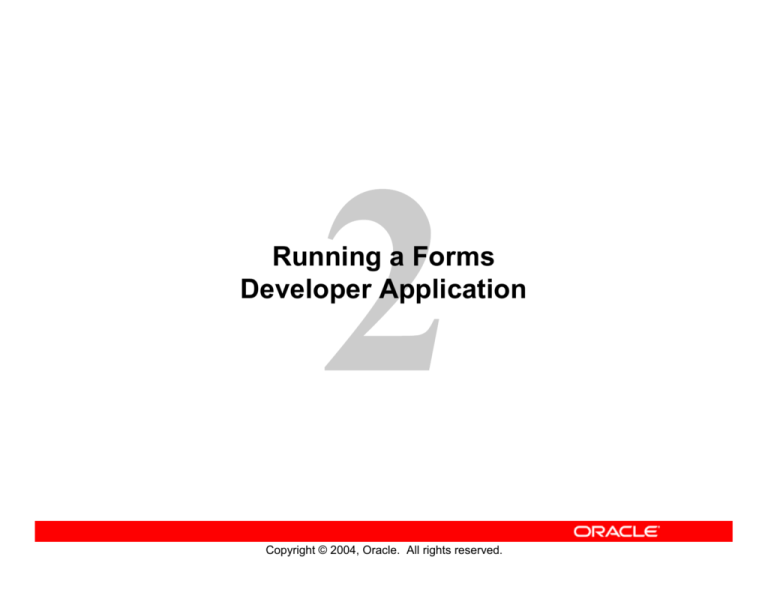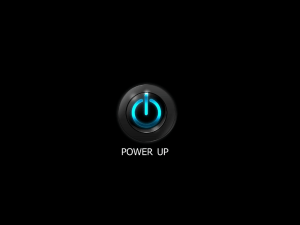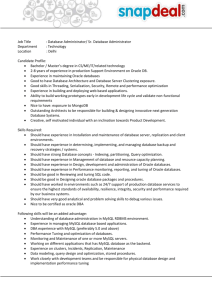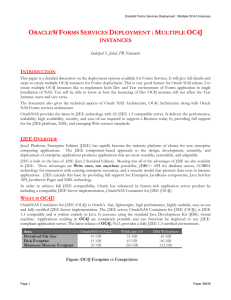
Running a Forms
Developer Application
Copyright © 2004, Oracle. All rights reserved.
Objectives
After completing this lesson, you should be able to do
the following:
• Start OC4J
• Describe the run-time environment
• Describe the elements in a running form
• Navigate a Forms application
• Describe the two main modes of operation
• Run a form in a Web browser
– Retrieve both restricted and unrestricted data
– Insert, update, and delete records
– Display database errors
Copyright © 2004, Oracle. All rights reserved.
Testing a Form: OC4J Overview
Oracle Application Server Containers for J2EE (OC4J)
is:
• Preferred to run Forms applications
• Included with Oracle Developer Suite to enable
testing
Copyright © 2004, Oracle. All rights reserved.
Testing a Form: Starting OC4J
•
On NT, run batch file to start
OC4J: startinst.bat.
•
OC4J starts in DOS window:
– Minimize window
– Closing window aborts OC4J
•
Run batch file to stop OC4J: stopinst.bat.
Copyright © 2004, Oracle. All rights reserved.
Running a Form
Oracle Forms Services deployment:
Browser URL
Java Applet
Copyright © 2004, Oracle. All rights reserved.
Running a Form: Browser
How do I
access this
application?
http://summit.com:8889/forms90/f90servlet?form=customers.fmx&userid=
http://summit.com:8889/forms90/f90servlet
?form=customers.fmx&userid=username/password@database
&buffer_records=NO&debug_messages=NO&array=YES
&query_only=NO
Copyright © 2004, Oracle. All rights reserved.
The Java Runtime Environment
•
•
The Forms applet runs in a Java Runtime
Environment (JRE) on the client machine.
Types of JREs:
– Java-enabled browser (native)
– JInitiator (Oracle-supplied plug-in to Web browser)
that provides:
Incremental Java archive (JAR) file downloading
JAR file caching
Applet instance caching
Automatic Java security configuration
Copyright © 2004, Oracle. All rights reserved.
Starting a Run-Time Session
Client Tier
1
Middle Tier: Application Server
Web Browser
URL http://summit.com:8889/forms90/f90
2
Web Server
Static HTML files
OC4J
or HTTP Server
Forms Services
3
Forms Servlet
Forms Listener Servlet
Forms Runtime Engine
Forms Application Executables
FMX files MMX files
PLX files
Copyright © 2004, Oracle. All rights reserved.
DB
Starting a Run-Time Session
Client Tier
Middle Tier: Application Server
Web Browser
URL http://summit.com:8889/forms90/f90
4
Web Server
Static HTML files
OC4J
or HTTP Server
Forms Services
Forms Servlet
Applet started
5
Forms Listener Servlet
Forms Runtime Engine
Forms Application Executables
FMX files MMX files
PLX files
Copyright © 2004, Oracle. All rights reserved.
DB
6
Starting a Run-Time Session
Client Tier
Middle Tier: Application Server
Web Browser
URL http://summit.com:8889/forms90/f90
7
Web Server
Static HTML files
OC4J
or HTTP Server
Forms Services
8
Forms Servlet
Forms Listener Servlet
Forms Runtime Engine
Forms Application Executables
FMX files MMX files
PLX files
Copyright © 2004, Oracle. All rights reserved.
DB
8
The Forms Servlet
URL Pointing to Forms Servlet
http://summit.com:8889/forms90/f90servlet?form=customers.f
Application Server
Desktop Client
Web Server
formsweb.cfg
basejini.html
URL PARAMETERS:
?form=customers.fmx
&userid=un/pw@db
&buffer_records=NO
...
Dynamic
HTML file is
created
Static HTML files
HTTP Server or OC4J
Forms Services
Forms Client
Base HTML files
Forms Servlet
Forms Listener Servlet
Forms Runtime Engine
Copyright © 2004, Oracle. All rights reserved.
The Forms Client
•
•
Generic Java applet
Responsibilities:
– Displays the form’s user interface
– Processes user interaction back to
Forms Services
– Processes incoming messages
from Forms Services
Copyright © 2004, Oracle. All rights reserved.
Desktop Client
Forms Client
Generic
Java applet
The Forms Listener Servlet
HTTP/
HTTPS
HTTP Server
or
OC4J
Forms
Listener
Servlet
Java Servlet that:
Forms
• Creates Forms
Runtime
Runtime process
Process
for each client
Middle Tier
• Stops the Runtime process at session end
• Manages network communications between client
and Forms Runtime process
• Communicates through Web server process
Copyright © 2004, Oracle. All rights reserved.
The Runtime Engine
The Forms Runtime Engine:
• Is a process (ifweb90) that runs on the
Application Server
• Manages application logic and processing
• Communicates with the client browser and the
database
Copyright © 2004, Oracle. All rights reserved.
What You See at Run Time
3
1
4
5
2
Copyright © 2004, Oracle. All rights reserved.
Identifying the Data Elements
1 2 3
4
5
6
7
8
Copyright © 2004, Oracle. All rights reserved.
9
10
Modes of Operation: Enter-Query Mode
Allows:
• Unrestricted and
restricted queries
• Query/Where dialog
box
• Record count by using
Query > Count Hits
Does not allow:
• Navigation out of
current data block
• Exiting run-time
session
• Certain functions
• Insert, update, delete
Copyright © 2004, Oracle. All rights reserved.
Modes of Operation: Normal Mode
Allows:
• Unrestricted queries
• Insert, update, delete
• Commit (Save)
• Navigation out of
current data block
• Exiting run-time
session
Does Not Allow:
• Restricted queries
• Query/Where dialog
box
Copyright © 2004, Oracle. All rights reserved.
Retrieving Data
Unrestricted query
A B
1
2
3
4
C
D
Restricted query
A B
1
2
A B C D
1
2
3
4
C
A B C D
1
2
3
4
Copyright © 2004, Oracle. All rights reserved.
D
Retrieving Restricted Data
•
•
•
•
•
•
Do not use quotation marks with character and
date items.
The LIKE operator is implied with % or _.
Use hash (#) in front of SQL operators.
Use Query/Where for complex query conditions.
Use default date format (DD-MON-RR) in
Query/Where.
Use quotes around literals in Query/Where.
Copyright © 2004, Oracle. All rights reserved.
Query/Where Dialog Box
•
Invoke by:
– Entering :variable_name
– Executing query
•
Used to write:
– Complex search conditions
– Queries with OR predicates
– ORDER BY clause
Copyright © 2004, Oracle. All rights reserved.
Query/Where Dialog Box
:i
:n
:i = 104 OR :n BETWEEN ‘F’ and ‘H’
Copyright © 2004, Oracle. All rights reserved.
Inserting, Updating, and Deleting
Memory
Deletes
Updates
Form module
Inserts
Copyright © 2004, Oracle. All rights reserved.
Making Changes Permanent
Memory
•
•
Select Action > Save to
make changes
permanent.
Select Action > Clear
All to discard changes.
Deletes
Updates
To commit or
rollback:
Menu
Inserts
or
Toolbar
Copyright © 2004, Oracle. All rights reserved.
Displaying Errors
•
•
•
Use to view Oracle errors
Select Help > Display Error
Shows Database Error window:
– SQL statement
– Error information
Copyright © 2004, Oracle. All rights reserved.
Summary
In this lesson, you should have learned that:
• You can use OC4J on the development machine to
run a Forms application in a Web browser
• At run time:
– The Forms Client is downloaded
– The Forms Servlet creates a start HTML file
– The Forms Listener Servlet starts a run-time
session and maintains communication between it
and the Forms Client
– The Runtime Engine carries out application logic
and maintains a database connection on behalf of
the Forms Client
Copyright © 2004, Oracle. All rights reserved.
Summary
•
•
•
•
When you run a form you see a Java applet
running in a browser and displaying a menu, menu
toolbar, console, and several kinds of data
elements.
Users navigate a Forms application using the
menu, toolbar, the mouse, buttons, or function
keys.
The two main modes of operation are Normal
mode and Enter-Query mode.
Executing a query returns all records, unless the
query is restricted by search criteria.
Copyright © 2004, Oracle. All rights reserved.
Summary
•
•
In normal mode you can insert, update, and delete
records and commit changes to the database.
You display database errors from the menu
(Help > Display Error)
Copyright © 2004, Oracle. All rights reserved.
Practice 2 Overview
This practice covers the following topics:
• Starting OC4J
• Running the course application:
–
–
–
–
–
Querying records
Inserting a record
Updating a record
Deleting a record
Displaying a database error
Copyright © 2004, Oracle. All rights reserved.








